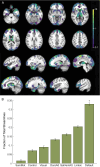Therapeutic DBS for OCD Suppresses the Default Mode Network
- PMID: 39719929
- PMCID: PMC11668941
- DOI: 10.1002/hbm.70106
Therapeutic DBS for OCD Suppresses the Default Mode Network
Abstract
Deep brain stimulation (DBS) of the anterior limb of the internal capsule (ALIC) is a circuit-based treatment for severe, refractory obsessive-compulsive disorder (OCD). The therapeutic effects of DBS are hypothesized to be mediated by direct modulation of a distributed cortico-striato-thalmo-cortical network underlying OCD symptoms. However, the exact underlying mechanism by which DBS exerts its therapeutic effects still remains unclear. In five participants receiving DBS for severe, refractory OCD (3 responders, 2 non-responders), we conducted a DBS On/Off cycling paradigm during the acquisition of functional MRI (23 fMRI runs) to determine the network effects of stimulation across a variety of bipolar configurations. We also performed tractography using diffusion-weighted imaging (DWI) to relate the functional impact of DBS to the underlying structural connectivity between active stimulation contacts and functional brain networks. We found that therapeutic DBS had a distributed effect, suppressing BOLD activity within regions such as the orbitofrontal cortex, dorsomedial prefrontal cortex, and subthalamic nuclei compared to non-therapeutic configurations. Many of the regions suppressed by therapeutic DBS were components of the default mode network (DMN). Moreover, the estimated stimulation field from the therapeutic configurations exhibited significant structural connectivity to core nodes of the DMN. Based upon these findings, we hypothesize that the suppression of the DMN by ALIC DBS is mediated by interruption of communication through structural white matter connections surrounding the DBS active contacts.
Keywords: DTI; OCD; anterior limb of the internal capsule; deep brain stimulation; default mode network; fMRI; tractography.
© 2024 The Author(s). Human Brain Mapping published by Wiley Periodicals LLC.
Conflict of interest statement
The authors declare no conflicts of interest.
Figures




Update of
-
Therapeutic DBS for OCD Suppresses the Default Mode Network.bioRxiv [Preprint]. 2024 Jul 24:2024.07.21.601827. doi: 10.1101/2024.07.21.601827. bioRxiv. 2024. Update in: Hum Brain Mapp. 2024 Dec 15;45(18):e70106. doi: 10.1002/hbm.70106. PMID: 39091832 Free PMC article. Updated. Preprint.
Similar articles
-
Therapeutic DBS for OCD Suppresses the Default Mode Network.bioRxiv [Preprint]. 2024 Jul 24:2024.07.21.601827. doi: 10.1101/2024.07.21.601827. bioRxiv. 2024. Update in: Hum Brain Mapp. 2024 Dec 15;45(18):e70106. doi: 10.1002/hbm.70106. PMID: 39091832 Free PMC article. Updated. Preprint.
-
A Randomized Trial Directly Comparing Ventral Capsule and Anteromedial Subthalamic Nucleus Stimulation in Obsessive-Compulsive Disorder: Clinical and Imaging Evidence for Dissociable Effects.Biol Psychiatry. 2019 May 1;85(9):726-734. doi: 10.1016/j.biopsych.2019.01.017. Epub 2019 Jan 30. Biol Psychiatry. 2019. PMID: 30853111 Free PMC article. Clinical Trial.
-
A Unified Functional Network Target for Deep Brain Stimulation in Obsessive-Compulsive Disorder.Biol Psychiatry. 2021 Nov 15;90(10):701-713. doi: 10.1016/j.biopsych.2021.04.006. Epub 2021 Apr 20. Biol Psychiatry. 2021. PMID: 34134839
-
Neurocircuitry of Deep Brain Stimulation for Obsessive-Compulsive Disorder as Revealed by Tractography: A Systematic Review.Front Psychiatry. 2021 Jul 1;12:680484. doi: 10.3389/fpsyt.2021.680484. eCollection 2021. Front Psychiatry. 2021. PMID: 34276448 Free PMC article.
-
Role of the dorsal anterior cingulate cortex in obsessive-compulsive disorder: converging evidence from cognitive neuroscience and psychiatric neurosurgery.J Neurosurg. 2017 Jan;126(1):132-147. doi: 10.3171/2016.1.JNS15601. Epub 2016 Apr 1. J Neurosurg. 2017. PMID: 27035167
Cited by
-
Aberrant dynamics of the default mode network activity in patients with obsessive-compulsive disorder.Cogn Neurodyn. 2025 Dec;19(1):93. doi: 10.1007/s11571-025-10288-0. Epub 2025 Jun 17. Cogn Neurodyn. 2025. PMID: 40538969
-
Invasive Brain Mapping Identifies Personalized Therapeutic Neuromodulation Targets for Obsessive-Compulsive Disorder.medRxiv [Preprint]. 2025 Mar 17:2025.03.14.25323348. doi: 10.1101/2025.03.14.25323348. medRxiv. 2025. PMID: 40166548 Free PMC article. Preprint.
References
-
- Baldermann, J. C. , Schüller T., Kohl S., et al. 2021. “Connectomic Deep Brain Stimulation for Obsessive‐Compulsive Disorder.” Biological Psychiatry 90, no. 10: 678–688. - PubMed

